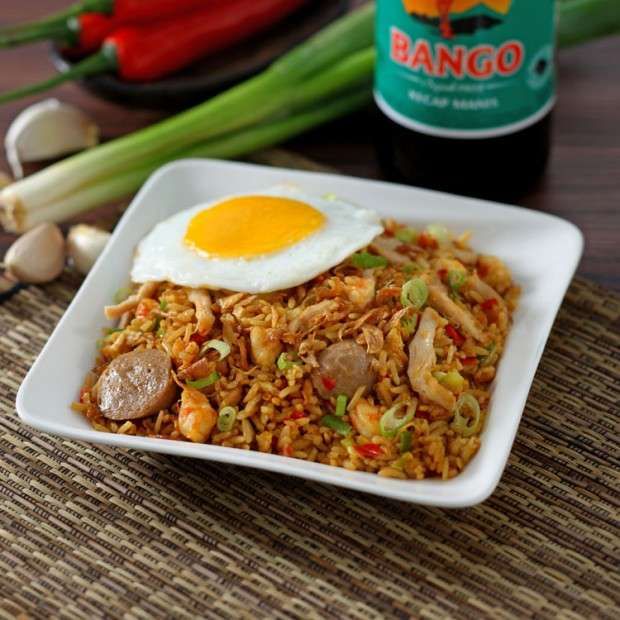
Nasi goreng (English pronunciation: /ˌnɑːsi ɡɒˈrɛŋ/) is a Southeast Asian fried rice dish, usually cooked with pieces of meat and vegetables. One of Indonesia's national dishes,[1][2] it is also endemic in Malay-speaking communities in countries such as Malaysia, Singapore and Brunei, and has gained popularity in Sri Lanka through migrations from the Malay Archipelago,[3] in countries like Suriname via Indonesian immigrant communities,[4] and in the Netherlands through its colonial ties with Indonesia.[5] Nasi goreng is distinguished from other Asian fried rice preparations by its distinct smoky aroma, and caramelised yet savoury undertones of flavour. There is no single defined recipe for nasi goreng, and its composition and preparation varies greatly from household to household.
Nasi goreng has long been considered an important staple of Indonesian cuisine.[6] In 2018, it is officially recognized by the Indonesian government as one of the country's six national dishes.[1] A ubiquitous meal throughout Indonesia, particularly for breakfast, it can be enjoyed in simple versions from a tin plate at a roadside food stall, eaten on porcelain in restaurants, or collected from the buffet tables of dinner parties in urban cities like Jakarta.[7] Premixed packaged seasonings for nasi goreng are widely available for purchase, and microwave-heated frozen versions of nasi goreng may be found in convenience store outlets throughout Indonesia.
The term nasi goreng means "fried rice" in both the Indonesian and Malay languages.[8][9] The Cambridge English Dictionary defines nasi goreng as an "Indonesian rice dish with pieces of meat and vegetables added",[10] although this dish is just as common in neighbouring Malaysia and Singapore as a cultural staple
Similar to other fried rice recipes in Asia, some commentators have suggested that Indonesian-style nasi goreng can trace its origin from Southern Chinese fried rice, and was likely developed as a way to avoid wasting rice.[13][14][15] The Chinese influences upon Indonesian cuisine can be seen in mie goreng that appeared simultaneously with the introduction of the stir frying technique that required the use of a Chinese wok.[16] In China, the stir frying technique became increasingly popular during Ming dynasty (1368–1644 CE).[17] The common soy sauce has its origin in 2nd century CE China, however, kecap manis (sweet soy sauce) was developed in Indonesia with a generous addition of local palm sugar.[18]
However, it is unclear when the peoples of present-day Indonesia began to adopt the practice of cooking fried rice. The trade between China and the Indonesian archipelago flourished from the era of Srivijaya around the 10th century and intensified in the Majapahit era around the 15th century. By that time Chinese immigrants had begun to settle in the archipelago, bringing along with them their culture and cuisine. Chinese people usually favour freshly cooked hot food, and in their culture it is taboo to throw away uneaten foodstuffs.[13] As a result, the previous day's leftover rice was often recooked in the morning. Gregory Rodgers suggested that frying the rice could prevent the propagation of dangerous microbes, especially in pre-refrigeration technology Indonesia and also avoid the need to throw out precious food.[19]
Writer Fadly Rahman from Padjajaran University claimed that there is no historical evidence which proves that nasi goreng is native to Indonesia, and suggested another theory besides Chinese influence: that nasi goreng was actually inspired by a Middle Eastern dish called pilaf, which is rice cooked in seasoned broth.[20] A particular variant, Betawi-style nasi goreng kambing (goat fried rice), uses mutton or goat meat (traditionally favoured by Arab Indonesians), rich spices and minyak samin (ghee), all typical ingredients used in the preparation of Middle-eastern pilaf.[21]
Nasi goreng was considered as part of the Indies culture during the colonial period. The mention of nasi goreng appears in colonial literature of Dutch East Indies, such as in the Student Hidjo by Marco Kartodikoromo, a serial story published in Sinar Hindia newspaper in 1918.[13] It was mentioned in a 1925 Dutch cookbook Groot Nieuw Volledig Oost Indisch Kookboek.[22] Trade between the Netherlands and the Dutch East Indies during that time has increased the popularity of Indonesian-style nasi goreng to the world